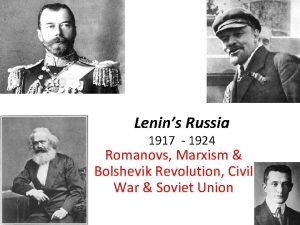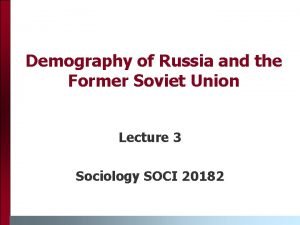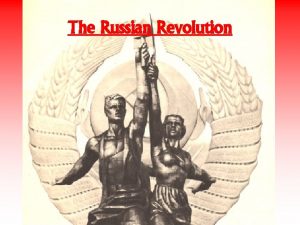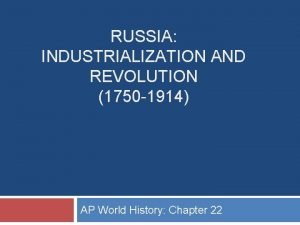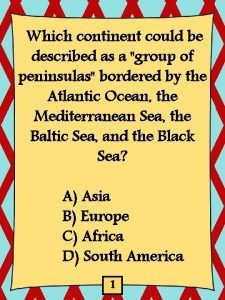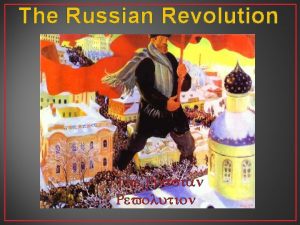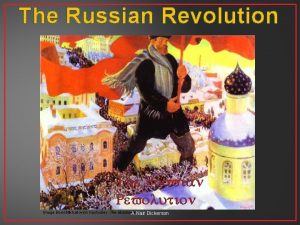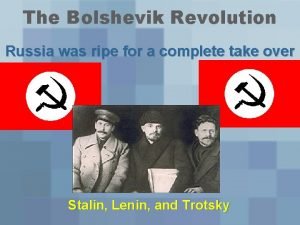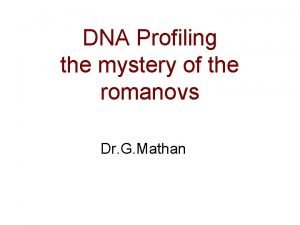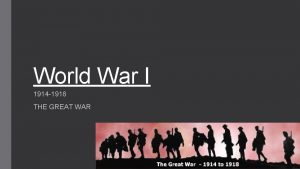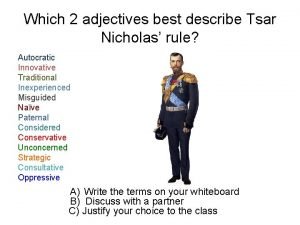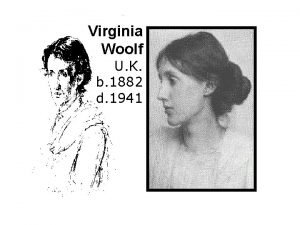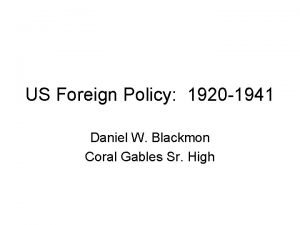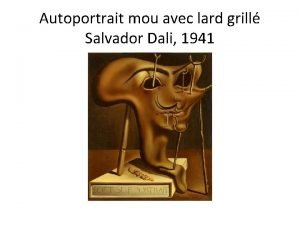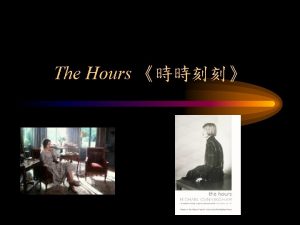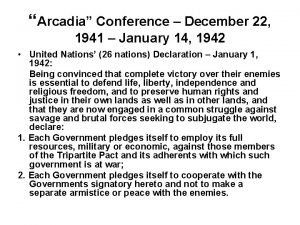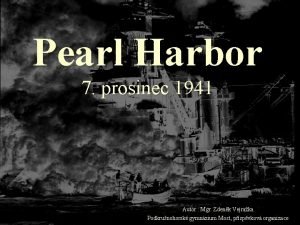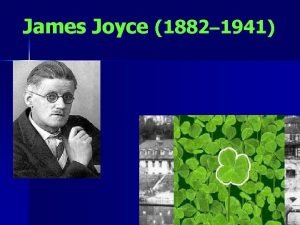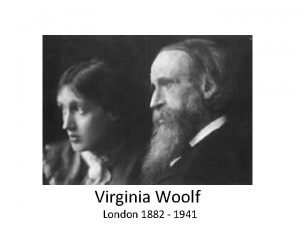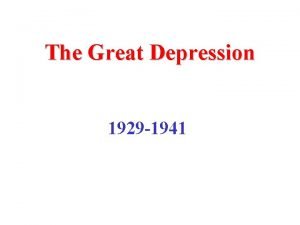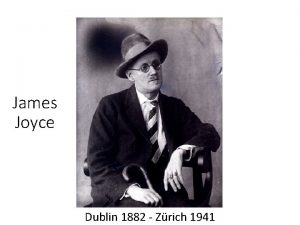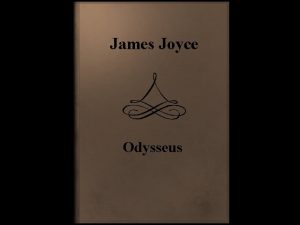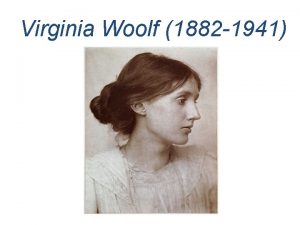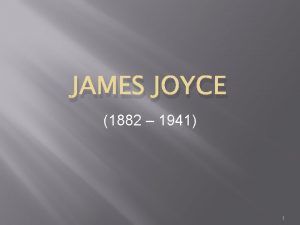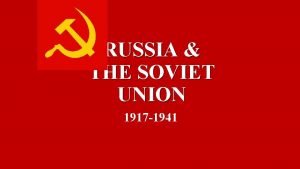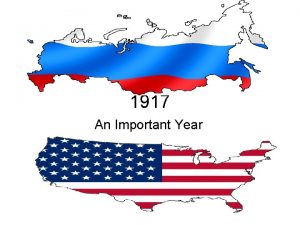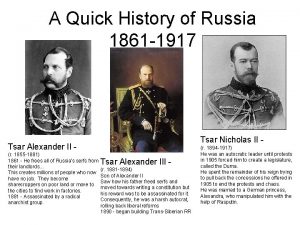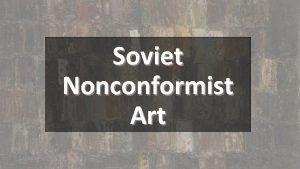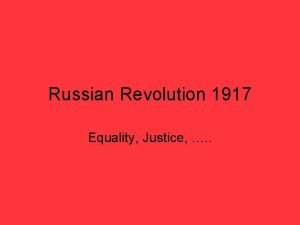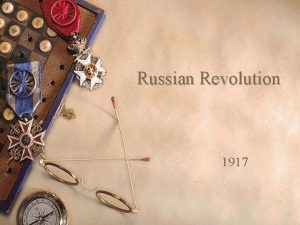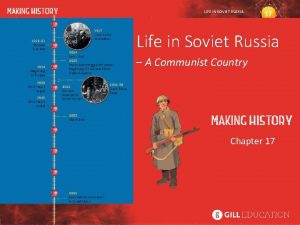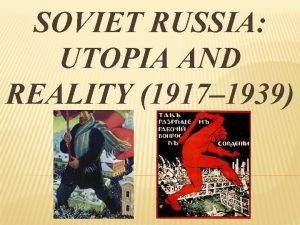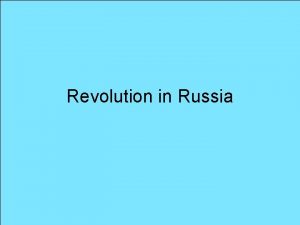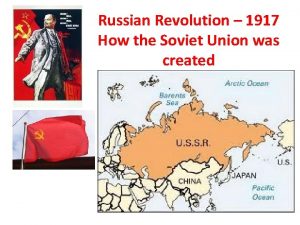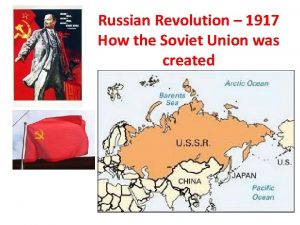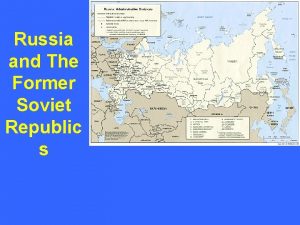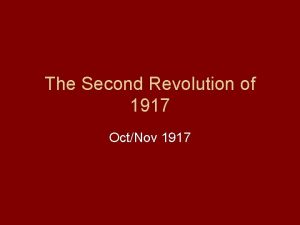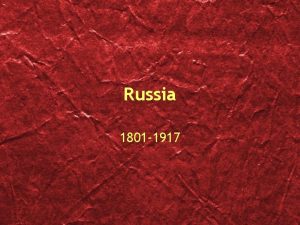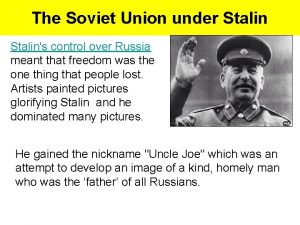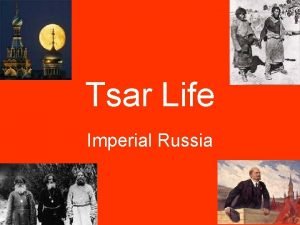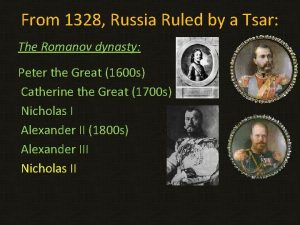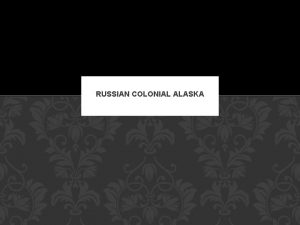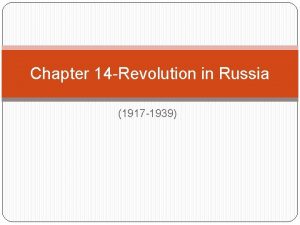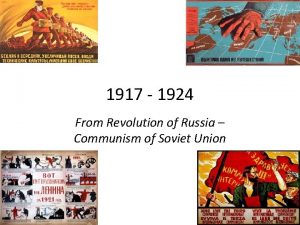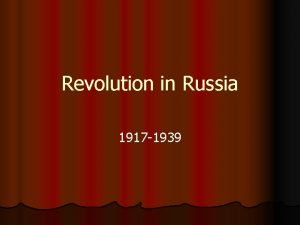SOVIET REVOLUTION 1917 1941 Russia under the Tsar


































- Slides: 34

SOVIET REVOLUTION 1917 -1941

Russia under the Tsar Russian society was full of differences and was stratified

Russia under the Tsar The war against Japan left a general impression that Western countries more powerful than Asian countries Russo-Japanese War - Russia lost to Japan A shame as West had lost to an Asian country People blamed the Tsar and opposed him

Russia under the Tsar

Russia under the Tsar In the Bloody Sunday incident, in 1905: 200, 000 workers marched to Tsar with petition They were loyal to Tsar but army thought otherwise and opened fire Tsar was blamed and revolution took place Tsar had no choice but to make changes: such as accepting a Duma

Russia under the Tsar The tsar’s government had its strengths: – Peasants loved him – The Duma did not reduce his power – The powerful church supported the dynasty – Government and army were in the hands of nobles who backed the tsar – There was a secret police and press censorship

Russia under the Tsar The Tsar’s government had it weaknesses: – – – Humiliation in war against Japan Different nationalities Difficult to govern due to bad communications The tsar was an autocrat There were groups opposing the tsar: • • Kadet (middle classes) Social revolutionaries Communists (bolsheviks and mensheviks) Political disorders ended in the assassination of politicians

1917 Revolution

Opposition to the Tsar Unhappiness of the people: – Middle Class: unhappy that they were not consulted in making decision in the government. – Town workers: these were mostly factory – Peasants: did not work on own land lived in bad condition – went against Tsar as Tsar did not improved their conditions

Opposition to the Tsar Russia in WW 1: – Makan (food ) not enough - not enough farmers, food taken away for soldiers – Army not good - lost many battles – Trouble at work - worked in bad living condition to produce more weapons – Inflation - prices increased because of lack of food and other products

Opposition to the Tsar Ineffective rule of the Tsar: – bad mistake to be involved in the war – left running of country to Tsarina and Rasputin, who was corrupted – ordered people to be shot at during Bloody Sunday incident – people lost confidence in the Tsar

Opposition to the Tsar Political opposition: – Absolute monarchy - complete control under Tsar – Liberals - government to be democratic – Social Revolutionaries - workers to gain power through violence and rule – Social Democrats - establish communist state (Mensheviks and Bolsheviks)

Events of the Revolution 7 March Steel workers go on strike. 8 March International Women’s Day – demonstrations/ bread riots. 9– 10 March More demonstrations/strikes – Tsarina calls in the army. 11 March Troops fire on crowds. The Duma urges action – Tsar dissolves the Duma. 12 March Soldiers mutiny and join riots. Soldiers and workers set up the ‘Petrograd Soviet’ of 2, 500 elected deputies (i. e. the Tsar’s government had fallen/ Russia had 2 governments) 13 March Duma sets up a ‘Provisional Government’, led by Kerensky. The Tsar gets on the train to Petrograd, but (on 14 March) is arrested on the way and (on 15 March) abdicates.

The Provisional Government The February Revolution was a popular uprising which brought the middle class to power. The Duma took over the government, and it set up a ‘provisional government’ – a temporary 12 -man executive led by Alexander Kerensky. It was a moderate government, and – although faced by difficult problems – it tried to rule Russia in a way which was not too revolutionary. The Provisional Government's main mistake was to carry on the war. The burden proved disastrous as it tried to face threat of the Bolshevik Communists, who were working through the Soviets to bring down the government.

Events of the Provisional Government March The Provisional Government was faced by massive problems (inflation, hunger, peasant riots, war, Bolshevik and Tsarist revolutionaries). The Petrograd Soviet issued Order No. 1 – workers and soldiers must obey the Provisional Government only if the Soviet agrees. However, the Soviets were still controlled by the Mensheviks (moderate Communists). April The German government smuggled the Bolshevik leader Lenin back into Russia. He published his manifesto: the ‘April Theses’. June Failure of the June military offensive against Austria. July Bolshevik riots – the July Days – were defeated, but the Bolshevik Party was not banned. August General Kornilov revolted, but was defeated by the Bolsheviks. Sept The Bolsheviks (extremist Communists) took over the Petrograd Soviet (Trotsky became its President). 6– 7 Nov (24– 25 October old style) Bolshevik Revolution.

Bolshevik Revolution. November 1917 By November 1917 the Provisional Government was in complete collapse. In the meantime, the Bolshevik party, helped by German money, had built up an efficient party organisation, a brilliant propaganda machine, and a powerful private army (the Red Guards). When Lenin moved to take over, the Provisional Government was unable to stop him, and the 'November Revolution' was less of a revolution than a coup d'état.

The abandonment of the Constituent Assembly The Treaty of Brest-Litovsk 1918 The Civil War 19181921 The execution of Tsar Nicholas II 1918 Factors that helped Lenin impose Communist control in Russia 1917 -1924. War Communism The Cheka Success of the New Economic Policy The Kronstadt Revolt 1921

Events of November 1917 (The October Revolution) 6 November Red Guards took over bridges and the telephone exchange. 7 November Red Guards took over banks, government buildings, and the railway stations. The cruiser Aurora shelled the Winter Palace. That night (9. 40 pm) the Red Guards took the Winter Palace and arrested the Provisional Government leaders. 8 November Lenin announced the new Communist Government

The Bolshevik Russia In November 1917 the Bolsheviks set up an extreme Communist state. It implemented Communist principles, but it also brought in a 'dictatorship of the proletariat', where terror was used to force people to live like Communists. The Bolsheviks needed to establish firm rule because their control of Russia was threatened by a Civil War

Lenin’s State 1917 -1921 After the elections a new government was established but Lenin changed it to an autocratic government They signed the Peace of Brest-Litovsk to leave WW 1 Lenin introduced communist laws mainly related to land industry Society became communist A totalitarian state was created with the Cheka or political police, and the Tsar was killed Severe rules known as War Communism were fixed.

The Brest-Litovsk Treaty Russian territory ceded to Germany

The Civil War Causes: – Challenge to the bolsheviks: · Social revolutionaries rejected from the assembly · The Mensheviks · The Tsarists · Former army officers angry about Brest-Litovsk · Landords who lost their land – Czech legion – World opposition to world revolution

The Civil War Events of the Civil War 1918– 1921 • The war lasted 3 years. • White armies led by Generals Yudenich and Denikin attacked Russia from the west, Admiral Kolchak from the east. • The Tsar and his family were put to death. • The Red Army defeated Kolchak in 1919 – after this the British, American and French armies went home. • The civil war caused shortages, famine and disease - millions died. There were many cruel atrocities. • The last White army in Russia was defeated in the Crimea in 1920. • The Red Army invaded Poland in 1921, but was defeated and driven back. • In 1922 The Tenth Party Congress declared the Union of Soviet Socialist Republics


The Civil War Reasons for the Bolsheviks’ victory: – Whites were disunited – Trotsky was the great strategist of the Red Army – Communist Russian felt they were fighting for a better world – War communism (nationalization of factories) – Terror (Cheka) – Bolsheviks controlled vital cities and railways

New Economic Policy, 1921 -24 After 3 years of war communism, a mutiny at the Kronstadt naval base scared the Bolsheviks, and they realised that they were pressing the people too hard. Lenin – much to the annoyance of hard-line Communists – brought in the New Economic Policy, which allowed some free enterprise, and concentrated on stimulating production


Stalin takes power, 1924 -29 When Lenin died in 1924, everybody expected Trotsky to take over the leadership. Instead, Stalin schemed his way into power, using his position as General Secretary, and a series of ruthless political moves (he eliminated all his political opponents)

Collectivisation Soviet agriculture was backwards Food was needed for workers in the towns NEP was not working Town-workers were needed Cash crops were needed Kulaks opposed communism

Industry and the 5 -Year Plans were drawn up by GOSPLAN (the state planning organisation) Targets were set for every industry, each region, each mine and factory, each foreman and even every worker. Foreign experts & engineers were called in Workers were bombarded with propaganda, posters, slogans and radio broadcasts. Workers were fined if they did not meet their targets. Alexei Stakhanov (who cut an amazing 102 tons of coal in one shift) was held up as an example. Good workers could become ‘Stakhanovites' and win a medal. (After the First 5 -year plan revealed a shortage of workers) women were attracted by new crèches and day-care centres so that mothers could work. For big engineering projects such as dams or canals, slave labour (such as political opponents, kulaks or Jews) was used. There was a concentration on heavy industry at the expense of consumer goods or good housing. Stalin attacked the Muslim faith because he thought it was holding back industrialisation.

Industry and the 5 -Year Plans Successes – The USSR was turned into a modern state (which was able to resist Hitler's invasion). – There was genuine Communist enthusiasm among the young ‘Pioneers’. Failures – Poorly organised – inefficiency, duplication of effort and waste. – Appalling human cost: • • – There were huge achievements in the following areas: • • • • • new cities dams/ hydroelectric power transport & communications the Moscow Underground farm machinery electricity coal steel fertilizers plastic no unemployment doctors & medicine education. • • discipline (sacked if late) secret police slave labour camps (for those who made mistakes) accidents & deaths (100, 000 workers died building the Belomor Canal) few consumer goods poor housing wages FELL no human rights – Some historians claim the tsars had done the ‘spadework’, setting up the basis for industrialisation, and that Stalin’s effort had very little effect on a process that would have happened anyway.

Stalin’s Terror Stalin wanted to control the country He used a complete terror apparatus: – Secret police – Great purges against: • • • Political opponents The Army The Church Ethnic groups Ordianry people He created a cult of his figure

Results of Terror The results of terror were: – Russification – Russia came to dominate the whole USSR. – Orthodox Church attacked – Twenty million arrested – perhaps half died. – Terror – People lived in fear of the Secret Police. – Industry – grew (the Terror provided free slave labour), but technology and science were held back by loss of top engineers and scientists. – Stalin Cult – Gulag – Army and navy weakened by purges of leading officers – Purges – political opponents eliminated

The Great Patriotic War When Germany attacked the USSR in 1941, Stalin used the same ruthlessness to defend his country. The defence of the USSR was the bloodiest war in history and cost the lives of millions of people and the destruction of thousands of villages, towns and cities. The final victory in 1945 was, like everything else, put down to the personal leadership of Stalin by the Soviet propaganda machine. After the war, Stalin built up the USSR as a superpower, in opposition to the USA. This conflict was known as the Cold War. Stalin died in 1953.
 Russia 1917
Russia 1917 Meanwhile in soviet russia
Meanwhile in soviet russia Population pyramid russia
Population pyramid russia March 1917 revolution
March 1917 revolution Russian revolution of 1917 definition ap world history
Russian revolution of 1917 definition ap world history Russian revolution 1917
Russian revolution 1917 Which letter represents the rhine river?
Which letter represents the rhine river? In the view of this cartoonist russia under
In the view of this cartoonist russia under In the view of this cartoonist russia under
In the view of this cartoonist russia under Why was russia ripe for revolution ww1
Why was russia ripe for revolution ww1 Tsar
Tsar Wilhelm george and nicholas
Wilhelm george and nicholas Propaganda adjectives
Propaganda adjectives Tsar
Tsar You should hope that this game will be over soon
You should hope that this game will be over soon Russian revolution vs french revolution
Russian revolution vs french revolution The third agricultural revolution
The third agricultural revolution 1941-1882
1941-1882 1941
1941 Salvador dali autoportrait mou avec du lard grillé analyse
Salvador dali autoportrait mou avec du lard grillé analyse Stream-of-consciousness technique
Stream-of-consciousness technique Suicide note virginia woolf
Suicide note virginia woolf Arcadia conference 1941
Arcadia conference 1941 Prosinec 1941
Prosinec 1941 1941-1882
1941-1882 1941-1882
1941-1882 1941-1882
1941-1882 1941
1941 1941-1882
1941-1882 1941-1882
1941-1882 1978-1941
1978-1941 Kode kentongan
Kode kentongan Leslie stephen virginia woolf
Leslie stephen virginia woolf 1882-1941
1882-1941 Di cavalcanti mulata com pássaro
Di cavalcanti mulata com pássaro
